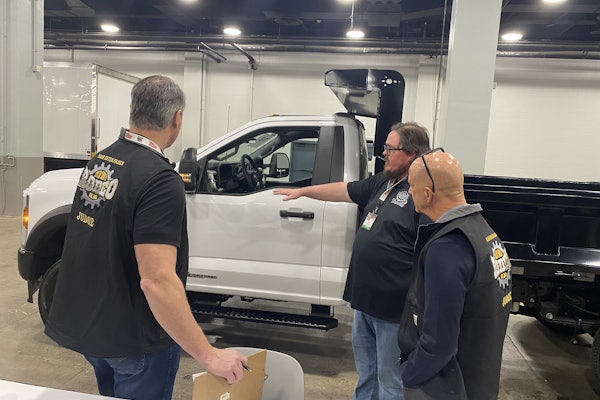Times have changed since Bob Jeffries secured one of his first jobs in the trucking industry. In 1978, when he worked starting trucks as part of his duties on a fuel island, he could be confident that the engines would remain running until the end of the day.
“Now we see applications where the starts can be as high as 80 to 120 per day,” observes the industry veteran, now the manager of fleet operations and service for Remy Inc., the maker of Delco Remy alternators.
Trucks that operate in urban environments face the demands of stop-and-go traffic as well as the anti-idling legislation that limits the opportunity to recharge batteries. These are only a few examples of the challenges that have emerged for electrical systems.
A modern refuse vehicle, for example, can draw between 240 and 280 amps when all four stages of the electronic brake retarder are engaged. “There is no alternator in the world that will handle that at full idle,” Jeffries notes.
To compound matters, an OEM that chooses the size of an original alternator may be unaware of a vehicle owner’s plans to add a lift gate or a snowplow with a 12-volt DC motor. Some Auxiliary Power Units also will need to have batteries of their own.
“If we consider the sleeper area of the cab, there are unlimited types of additional amperage demands that might be lurking in there – from microwaves, to TVs, to game systems, to climate controls,” adds Fred Padgett, Robert Bosch’s group product manager, starters and alternators.
In addition to facing ever-increasing workloads, alternators are being attacked by higher temperatures and shrinking real estate under the hood. Most of the warm plumbing associated with Exhaust Gas Recirculation systems is already running next to the alternators, and every recent change in standards by the Environmental Protection Agency has forced engineers to find new ways to enhance component designs.
The good news is that the related updates are making an undeniable difference in the lifespan of these components. The greases that coat bearings have been chosen because they maintain a required viscosity at higher temperatures, while wiring has been shrouded in an extra layer of insulation. Button diodes have been replaced by press-fit designs to ensure that a greater amount of surface area remains in contact with the heat sink, Jeffries says.
“Later model alternators have gone to dual internal fans, which pull the cooling air in through both the front and the rear of the alternator. This is similar to what passenger car alternators did several years ago,” adds Padgett. “This way, the internal components of the alternator are cooled much more efficiently.”
But the unprecedented under-hood heats also have made it more important than ever to support the maintenance practices that will ensure a flow of cool air around the related parts.
DEMANDING APPLICATIONS
Refuse vehicles face particular challenges. As the equipment drives over the limestone roadways in a landfill site, the dust will begin to coat the intakes at the back of an alternator, eventually covering the heat sinks in an unwelcome layer of filthy insulation.
It isn’t an easy challenge to prevent. The alternators on farming equipment may be protected by dust shields, but those vehicles seldom require more than 80 amps of capacity. A high-output alternator would be unlikely to be able to handle the heat if it was surrounded by a similar screen.
“There’s a lot more science that goes into the air movement of an alternator than someone will see on the surface,” Jeffries says.
Coated fins simply can be cleaned out with the blast of an air gun, he suggests, adding quickly that it should be done outside the shop rather than coating any nearby co-workers. Even a brush-style alternator will be able to withstand the cleaning process because of the tight clearances between the brushes and the slip ring.
That said, the industry veteran offers a caution – this is no place for a pressure washer or caustic cleaner.
The importance of these cleaning procedures cannot be overstated. The vast majority of alternator failures can be traced to solid state components such as diodes and rectifiers, Jeffries explains, referring to the impact of heat and time. In contrast, an analysis of Delco Remy cores shows that mechanical issues such as a failed bearing or worn pulley are “parts-per-million types of failures.”
The analysis of returned cores has even demonstrated another trend. Many alternators are replaced when there is nothing wrong in the first place.
More than 14 percent of the returned alternators work just fine, he says. They were simply replaced when maintenance teams failed to properly investigate a complaint that surrounds a failure to charge.
Padgett goes further than that. “As a remanufacturer, it doesn’t matter if we are talking alternators or starters, automotive or heavy-duty. Of all the units that are returned as alleged defective or warranty returns, nearly 50 percent of them have no fault found,” he says.
“A lot of technicians are getting fooled into replacing rotating electrical products by simply looking at the vehicle’s symptoms and not performing a proper starting and charging systems test.”
DOING DUE DILIGENCE
This is why the entire troubleshooting process needs to look at the alternator as part of an overall system.
“The best alternator in the world cannot charge dead batteries,” Jeffries says as an example. And the combination of a new alternator with a fresh set of batteries still will be ineffective if there is a problem with the cables that connect everything in the first place.
The first step in the investigation should involve a load test for the related batteries. Then it is a matter of following Technology & Maintenance Council (TMC) Recommended Practice 129.
A comprehensive troubleshooting process will analyze four circuits:
- The cranking circuit, which includes the cables that carry current to the starter, needs to be in working order to ensure quick cranking speeds in cold temperatures.
- The solenoid circuit is the one that travels from the battery, through a magnetic switch, to the SW terminal of the starter solenoid and back to the battery. Problems here will lead to issues such as a burned contact disc and terminals, leading to a failed start.
- The control circuit connects the start button to the magnetic switch’s coil, and a failure here can cause the starter solenoid to shift in and out.
- The charging circuit, meanwhile, is the one that connects the alternator and the battery.
The integrity of the cables can be checked with a traditional voltage drop test. Apply the rated output of the alternator with a load tester, and check the voltage at the alternator, terminals and batteries. The related readings should not vary by more than 0.5 volts.
If the voltage is dropping too much, connectors should be cleaned with a wire brush and re-tightened. Any replacement wires should be the same length and gauge as the wires that already existed.
Never check the charging system until you have performed a battery load test and confirmed that the batteries read at least 12.2 to 12.3 volts, Jeffries adds.
If these elements seem to be working as designed, it is time to focus on mechanical issues such as the condition of the belt that drives the alternator. Any auto tensioners also should be operating within its wear marks.
“On the newer vehicles, we are seeing more clutching pulleys and more fixed-mount alternators that require a belt-tensioning device. Both of these devices can fail, and only periodic visual and mechanical inspection can prevent further damage,” Padgett observes.
“If either one fails, you can end up with anything from premature alternator bearing failure to an entirely locked up alternator.”
Then it is a matter of checking the alternator itself. That test will require a 500-amp variable carbon pile load tester with an ammeter, a volt meter that can offer readings in 0.1-volt increments and a clamp-on inductive ammeter that can offer quick checks of the alternator current.
The first step involves clamping an induction pick-up around the alternator’s output cable. Without adding any electrical load, the engine should be held at 1,600 rpm. At this point, the batteries should be loaded down with a carbon pile. The ammeter reading will climb as the alternator tries to keep up with the load. Eventually, the reading will begin to drop as the load from the carbon pile exceeds the alternator’s output capabilities.
The maximum output should be within 10 percent of the rating that is found on the alternator’s label. The range of readings needs to exist because output can be affected by ambient temperature, Jeffries says, noting how ratings are based on 77







